外研版(2019)选择性必修第一册Unit 2 Onwards and Upwards Developing ideas 课件(共27张PPT,内镶嵌视频)
文档属性
| 名称 | 外研版(2019)选择性必修第一册Unit 2 Onwards and Upwards Developing ideas 课件(共27张PPT,内镶嵌视频) | 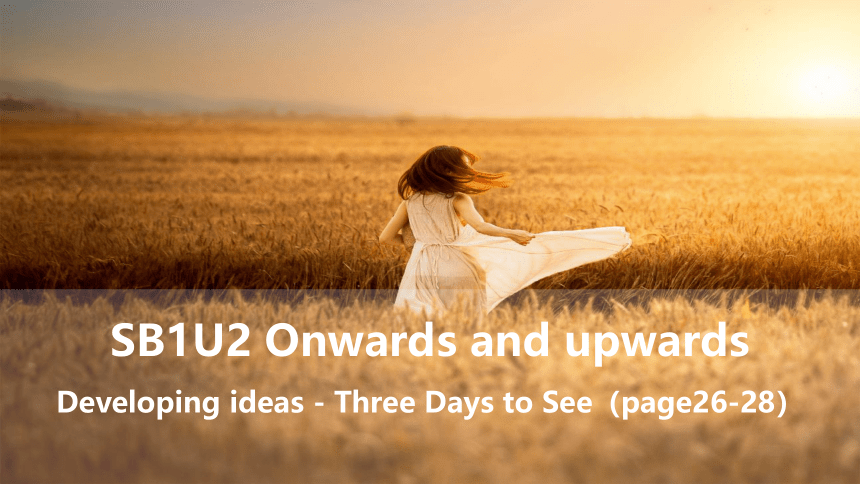 | |
| 格式 | pptx | ||
| 文件大小 | 13.3MB | ||
| 资源类型 | 教案 | ||
| 版本资源 | 外研版(2019) | ||
| 科目 | 英语 | ||
| 更新时间 | 2023-07-05 16:23:33 | ||
图片预览

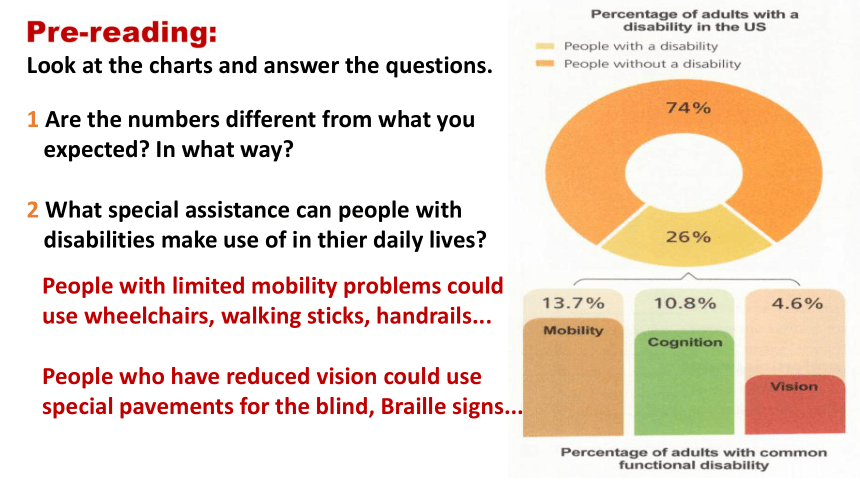
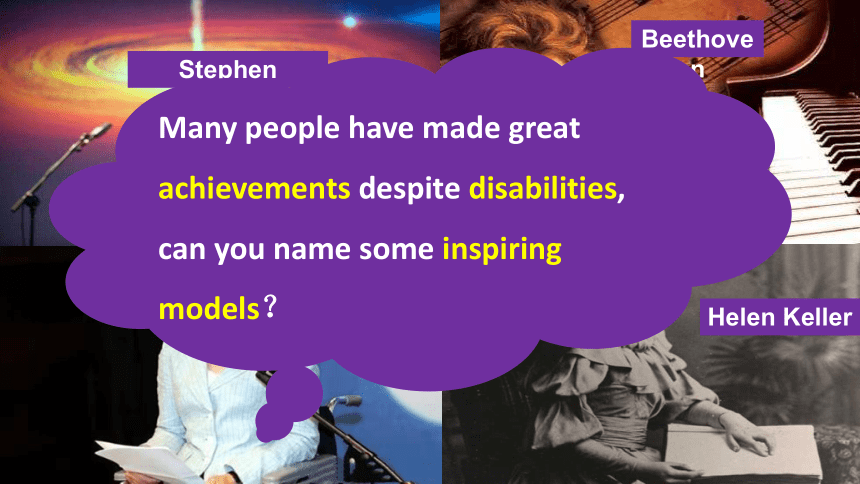
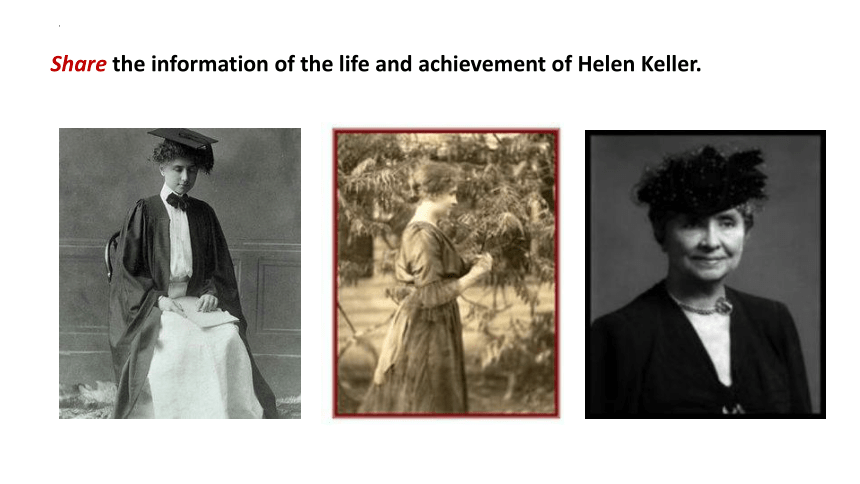
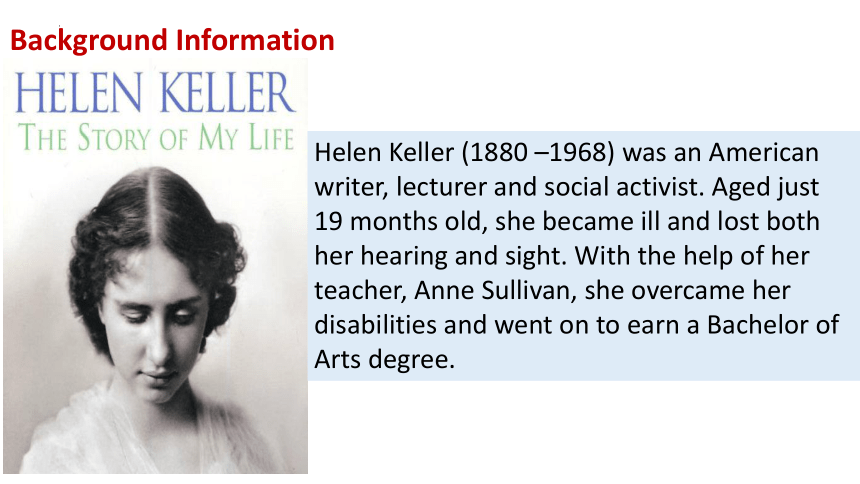
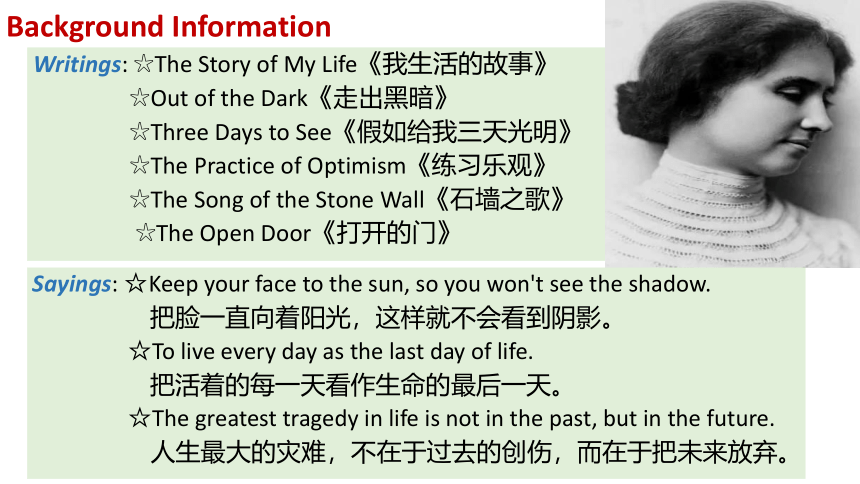
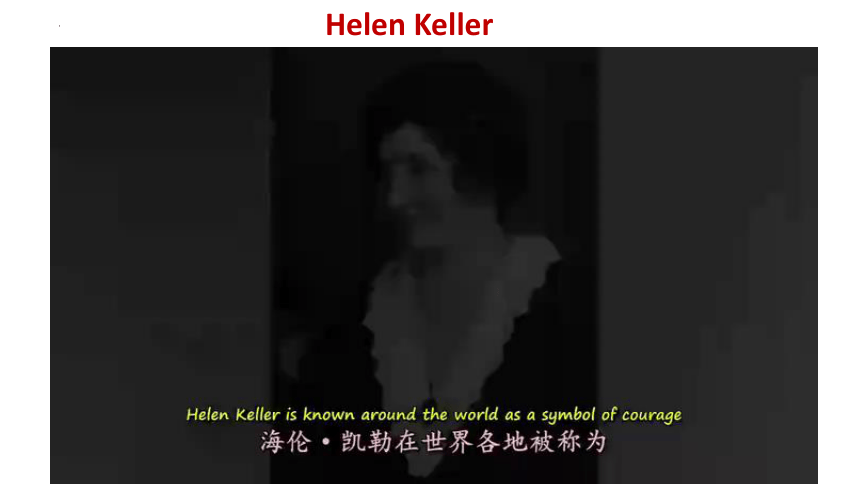
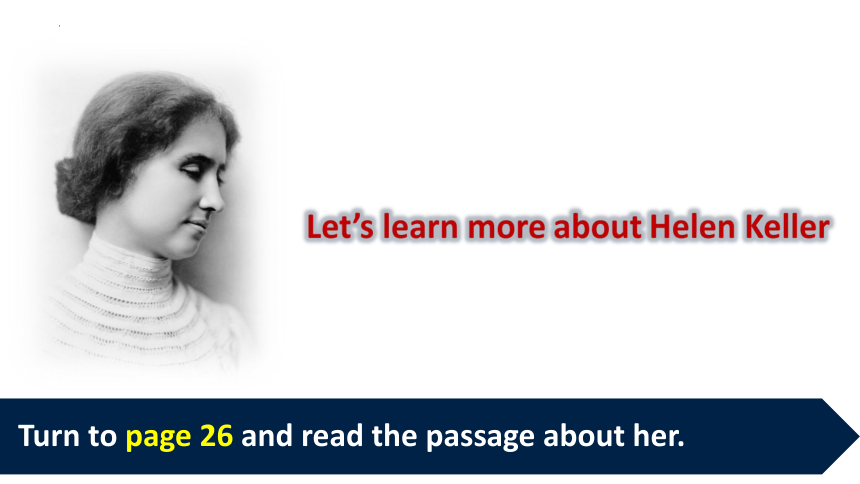
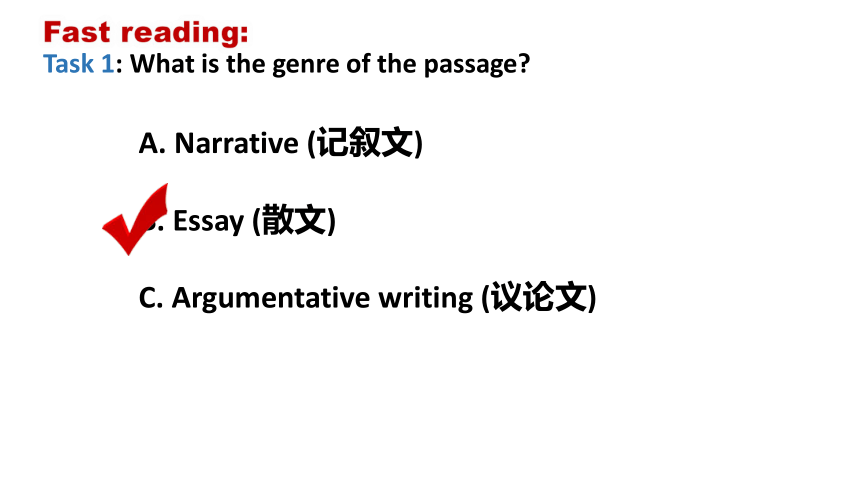
文档简介
(共27张PPT)
SB1U2 Onwards and upwards
Developing ideas - Three Days to See(page26-28)
Pre-reading:
Look at the charts and answer the questions.
1 Are the numbers different from what you expected In what way
2 What special assistance can people with disabilities make use of in thier daily lives
People with limited mobility problems could use wheelchairs, walking sticks, handrails...
People who have reduced vision could use
special pavements for the blind, Braille signs...
Stephen Hawking
Helen Keller
Beethoven
Zhang Haidi
Many people have made great achievements despite disabilities, can you name some inspiring models?
Share the information of the life and achievement of Helen Keller.
Helen Keller (1880 –1968) was an American writer, lecturer and social activist. Aged just 19 months old, she became ill and lost both her hearing and sight. With the help of her teacher, Anne Sullivan, she overcame her disabilities and went on to earn a Bachelor of Arts degree.
Background Information
Background Information
Writings: ☆The Story of My Life《我生活的故事》
☆Out of the Dark《走出黑暗》
☆Three Days to See《假如给我三天光明》
☆The Practice of Optimism《练习乐观》
☆The Song of the Stone Wall《石墙之歌》
☆The Open Door《打开的门》
Sayings: ☆Keep your face to the sun, so you won't see the shadow.
把脸一直向着阳光,这样就不会看到阴影。
☆To live every day as the last day of life.
把活着的每一天看作生命的最后一天。
☆The greatest tragedy in life is not in the past, but in the future.
人生最大的灾难,不在于过去的创伤,而在于把未来放弃。
Helen Keller
Let’s learn more about Helen Keller
Turn to page 26 and read the passage about her.
Fast reading:
Task 1: What is the genre of the passage
A. Narrative (记叙文)
B. Essay (散文)
C. Argumentative writing (议论文)
Fast reading:
Task 2: Find out the structure of the passage.
1. How many parts can we devide the passage into
Draw a mind map if possible.
2. What's the main idea of each part
P 1、2、3
P 4
P 5
P 6
P 7
P 8
the structure of the passage
Many people without a disability are
not appreciative of what they have
What Helen should do during
the given three days
Give one hint to people without a disability
eager to see
The plan of the three days
A hint to those who see
Fast reading:
Task 3: Choose the author’s purpose in writing the passage and
give your reasons.
A. To help readers understand what it is like to be blind.
B. To make readers without disabilities appreciate what
they have.
C. To persuade readers to care about the blind.
Careful reading:
Task 1: Read the passage and find out what the author would do if
she could see.
the first day
the second day
the third day
the first day (Para. 4)
On the first day, she would want to see the kind people who have helped her and accompanied her through life. Then she would like to see the books which have opened her mind. In the afternoon, she would take a long walk in the woods and appreciate the beauty of nature.
Check the answers
the second day (Para. 5)
On the second day, she would like to see a display of the progress of civilisation. She would go to the museums and spend the evening at a theater or at the movies.
Check the answers
the third day (Para. 6)
On the third day, she would again greet the dawn, anxious to discover new delights, new revelations of beauty. She would spend the third
day observing people in their day-to-day life.
Check the answers
The author would like to be able to see for three days. She would like to be able to see the people who have helped her and with whom she spends her time. She would like to see the books which have been read to her.
Careful reading:
Task 2: Read the passage and find the main wishes of the author.
Give an example.
Careful reading:
Task 3: Read the sentences from the passage and answer the questions.
1 What sentence structure is used repeatedly
What figure of speech is it
2 How does this technique help to express the author’s emotions
Careful reading:
Task 3: Read the sentences from the passage and answer the questions.
1 What sentence structure is used repeatedly
What figure of speech is it
A similar structure is used repeatedly.
Namely, “ Use ... as if ... Hear... as if ... Touch... as if ... ”.
It is parallelism(排比修辞).
1. What sentence structure is used here
Use... as if...
Hear... as if...
Touch... as if...
排比结构
Post reading
排比是一种文学技巧,是指用结构相似的表达、从句或句子。使内容更有节奏感,更有吸引力,更容易被记住。常用于文学作品和演讲中。
Careful reading:
Task 4: Read the sentences from the passage and answer the questions.
2 How does this technique help to express the author’s emotions
The use of parallelism in speech or writing allows speakers or writers to maintain a consistency within their work and creates a balanced flow of ideas. Moreover, parallelism can be used as a tool for persuasion.
Post-reading:
Think share(P13)
1. What qualities do both reading passages in this unit convey
2. Do you know of any stories about people with disabilities
Share one with the class.
3. How should we interact with people with disabilities?
Various answers are welcome. Just speak it out!
Group work: State your opinion
Give a talk about your opinion on the sentence from the passage.
1 Read the sentence carefully, think over the meaning and decide
whether you agree or disagree with it.
2 Organize your opinion and make notes.
3 Give your talk to the class.
Self evaluation
What dose the whole unit convey to us?
When we are facing difficulties and setbacks in life, we should
have a positive attitude;
never give up;
...
“Optimism is the faith that leads to achievement .
Nothing can be done without hope and confidence. ”
“乐观是通向成功的信念,
没有希望和信心,就一事无成”
---Helen Keller
Write a short essay about what you would do if today was your last day.
SB1U2 Onwards and upwards
Developing ideas - Three Days to See(page26-28)
Pre-reading:
Look at the charts and answer the questions.
1 Are the numbers different from what you expected In what way
2 What special assistance can people with disabilities make use of in thier daily lives
People with limited mobility problems could use wheelchairs, walking sticks, handrails...
People who have reduced vision could use
special pavements for the blind, Braille signs...
Stephen Hawking
Helen Keller
Beethoven
Zhang Haidi
Many people have made great achievements despite disabilities, can you name some inspiring models?
Share the information of the life and achievement of Helen Keller.
Helen Keller (1880 –1968) was an American writer, lecturer and social activist. Aged just 19 months old, she became ill and lost both her hearing and sight. With the help of her teacher, Anne Sullivan, she overcame her disabilities and went on to earn a Bachelor of Arts degree.
Background Information
Background Information
Writings: ☆The Story of My Life《我生活的故事》
☆Out of the Dark《走出黑暗》
☆Three Days to See《假如给我三天光明》
☆The Practice of Optimism《练习乐观》
☆The Song of the Stone Wall《石墙之歌》
☆The Open Door《打开的门》
Sayings: ☆Keep your face to the sun, so you won't see the shadow.
把脸一直向着阳光,这样就不会看到阴影。
☆To live every day as the last day of life.
把活着的每一天看作生命的最后一天。
☆The greatest tragedy in life is not in the past, but in the future.
人生最大的灾难,不在于过去的创伤,而在于把未来放弃。
Helen Keller
Let’s learn more about Helen Keller
Turn to page 26 and read the passage about her.
Fast reading:
Task 1: What is the genre of the passage
A. Narrative (记叙文)
B. Essay (散文)
C. Argumentative writing (议论文)
Fast reading:
Task 2: Find out the structure of the passage.
1. How many parts can we devide the passage into
Draw a mind map if possible.
2. What's the main idea of each part
P 1、2、3
P 4
P 5
P 6
P 7
P 8
the structure of the passage
Many people without a disability are
not appreciative of what they have
What Helen should do during
the given three days
Give one hint to people without a disability
eager to see
The plan of the three days
A hint to those who see
Fast reading:
Task 3: Choose the author’s purpose in writing the passage and
give your reasons.
A. To help readers understand what it is like to be blind.
B. To make readers without disabilities appreciate what
they have.
C. To persuade readers to care about the blind.
Careful reading:
Task 1: Read the passage and find out what the author would do if
she could see.
the first day
the second day
the third day
the first day (Para. 4)
On the first day, she would want to see the kind people who have helped her and accompanied her through life. Then she would like to see the books which have opened her mind. In the afternoon, she would take a long walk in the woods and appreciate the beauty of nature.
Check the answers
the second day (Para. 5)
On the second day, she would like to see a display of the progress of civilisation. She would go to the museums and spend the evening at a theater or at the movies.
Check the answers
the third day (Para. 6)
On the third day, she would again greet the dawn, anxious to discover new delights, new revelations of beauty. She would spend the third
day observing people in their day-to-day life.
Check the answers
The author would like to be able to see for three days. She would like to be able to see the people who have helped her and with whom she spends her time. She would like to see the books which have been read to her.
Careful reading:
Task 2: Read the passage and find the main wishes of the author.
Give an example.
Careful reading:
Task 3: Read the sentences from the passage and answer the questions.
1 What sentence structure is used repeatedly
What figure of speech is it
2 How does this technique help to express the author’s emotions
Careful reading:
Task 3: Read the sentences from the passage and answer the questions.
1 What sentence structure is used repeatedly
What figure of speech is it
A similar structure is used repeatedly.
Namely, “ Use ... as if ... Hear... as if ... Touch... as if ... ”.
It is parallelism(排比修辞).
1. What sentence structure is used here
Use... as if...
Hear... as if...
Touch... as if...
排比结构
Post reading
排比是一种文学技巧,是指用结构相似的表达、从句或句子。使内容更有节奏感,更有吸引力,更容易被记住。常用于文学作品和演讲中。
Careful reading:
Task 4: Read the sentences from the passage and answer the questions.
2 How does this technique help to express the author’s emotions
The use of parallelism in speech or writing allows speakers or writers to maintain a consistency within their work and creates a balanced flow of ideas. Moreover, parallelism can be used as a tool for persuasion.
Post-reading:
Think share(P13)
1. What qualities do both reading passages in this unit convey
2. Do you know of any stories about people with disabilities
Share one with the class.
3. How should we interact with people with disabilities?
Various answers are welcome. Just speak it out!
Group work: State your opinion
Give a talk about your opinion on the sentence from the passage.
1 Read the sentence carefully, think over the meaning and decide
whether you agree or disagree with it.
2 Organize your opinion and make notes.
3 Give your talk to the class.
Self evaluation
What dose the whole unit convey to us?
When we are facing difficulties and setbacks in life, we should
have a positive attitude;
never give up;
...
“Optimism is the faith that leads to achievement .
Nothing can be done without hope and confidence. ”
“乐观是通向成功的信念,
没有希望和信心,就一事无成”
---Helen Keller
Write a short essay about what you would do if today was your last day.
